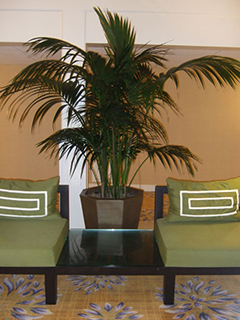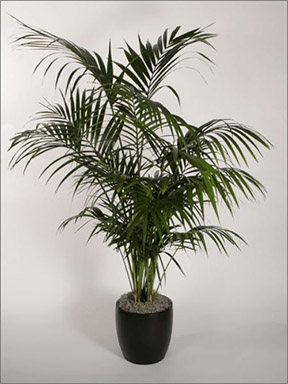Common Name: Kentia palm
Light Needs
Bright indirect light
Water Requirements
Light watering
Description:
Long lasting, slow-growing, large, dark green, graceful palm with spreading fronds that are thick and somewhat droopy at the tips.
Most commonly used varieties: ‘Kentia palm’
Long lasting, slow-growing, large, dark green, graceful palm with spreading fronds that are thick and somewhat droopy at the tips.
All palms have unique botanical features that set them apart from other plants. They have only one growing point, which is at the apex or end of the stem/trunk. This apical bud is the “heart” of all palms. Its removal from injury or disease will kill that stem of the plant. In addition, palms do not possess distinct vascular tissues called xylem or phloem, which transport food and water through most plants. Instead, they have a series of vascular bundles randomly scattered throughout the trunk tissue. Palms lack the cambium cells that are necessary for lateral growth in trees.
Howeia fosteriana tolerates the hot, dry conditions of the interior environment and doesn’t mind the lower light levels. Most of them can withstand sustained low light levels to 50 foot-candles, slowing to almost no growth and using very little water.
An ever so slightly moist medium. In low light, their root systems can be easily overwatered, causing root rot and eventual death of the plant. Determining the water needs of a kentia is tricky. This is partly because they are slow to give a sign that they are in trouble. Kentias take many weeks to send the visible signal to the foliage for us to “read.” The yellowing of the oldest leaf of a kentia can be the result of underwatering from two to three weeks before.
Watch for the signs of overwatering: brown frond tips that appear wet looking, perhaps ringed with yellow. Brown or gray new growth root and stem rot are also signs of chronic overwatering. A kentia that starts to flop open and needs to be staked to be held erect is a plant with a dying root system caused by too much water.
Each interiorscape setting has slightly different conditions and as a technician, you must be sensitive to those subtle changes and adjust your watering to fit. Watch for the signs of overwatering which can be brown frond tips that appear wet looking, perhaps ringed with yellow. Brown or gray new growth, and of course root and stem rot, are also signs of chronic overwatering. A kentia that starts to flop open and needs to be staked to be held erect is a plant with a dying root system caused by too much water.
The delicate root system of these plants dictate a gentle applying of water. Once you have determined the plant needs water, lightly add water pouring evenly around the edge of the grow pot. Avoid dumping it all in one spot, or on the stem. Sprinkle it carefully like a light spring rain and avoid dispensing so much water as to leave any in the saucer.
All Howeia fosteriana benefit from cleaning. Keep them healthy and clean by washing or wiping the fronds using mild castile soap and water. Don’t use leaf shine for all palms are very sensitive to chemicals. Besides, palms aren’t supposed to be shiny, a dull finish is a natural look for a palm. To get rid of dust, use white gloves or tube socks for a quick wipe down. If these come away with a yellowish tint, mites are present on the plant.
Spider mites, mealybugs, scale, thrips, and yes, even cyclamen mites are pests of the Howeias indoors. Though saying that, many kentias will go years with no pest problems at all.


